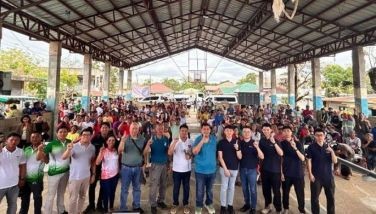The church atop the hill
October 17, 2005 | 12:00am
As one approaches Culión Island by boat, one sees that only a very small part of this mountainous island is actually inhabited. The rest is forest. But among the buildings the most prominent is the church on a hilltop.
That church has a history.
When Culión became a leper colony in 1906, there was already a church atop that hill but it was very much smaller and it was some 200 years old, built during Spanish times. It was inside a fort, a "cota." By 1917 that church was seen to be totally inadequate, with the number of lepers increasing eventually reaching over 5,000.
The Spanish Jesuit missionaries began asking for donations from bishops and other Philippine benefactors. It took a long time to collect a sufficient amount to construct a larger church.
The lepers themselves helped with their meager resources. A fair was held with booths and various forms of entertainment and a modest amount was added to the fund.
With the coming of the American Jesuits, donations to the Culión church began to be received from the United States and from Ireland. The Superior of the Philippine Jesuits, Father James T. G. Hayes (later Archbishop of Cagayan) obtained a donation of 5,000 dollars (10,000 pesos) from a donor who wished to remain anonymous.
In 1931 Father Hugh McNulty was appointed Superior of the Jesuits in Culión, and he set about building the church. Bids were requested from builders in Manila, but they were all very high, the lowest more than double the amount of money available. Moreover, all bids were withdrawn when it was learned that it was to be in a leper colony.
An American engineer named Williams came to Culión on some business, and when he heard of the predicament of a community needing a church but no builders would come to build it, he agreed to build it himself and at a cost much lower than the lowest bid received.
Before the church could be built, two dormitories in the area had to be relocated. So a dormitory building had to be erected elsewhere for boys and another for girls. Then the construction of the church began, and they completed it in only 130 work days, a little over four months.
It was a large fine structure, 120 feet long, 36 feet wide, and 46 feet high. The walls were of stone and mortar, the stone coming partly from the old church, partly from the excavations made for the building. The roof was of corrugated iron sheets, the drum-like (or tunnel-shaped) ceiling was of wood and ornately painted.
The first Mass (attended by a large crowd estimated at 2,270) was celebrated on 28 August 1933, the celebrant being Father Francisco X. Rello, the Spanish Jesuit who holds the record of having stayed longest in Culión. (He spent his last years at the Ateneo de Manila in Loyola Heights.)
To the foregoing account (the facts are taken from Father Carl Hausmann’s manuscript History of Culión) we must add a very recent development.
By the year 2000 (67 years after that first Mass) the church needed renovation. This was undertaken by Father Gabriel Gonzalez S.J., with financial backing from the Foundation organized by the late Father Olazábal) which has done much for the improvement of life in Culión. The church is now attractively elegant, with a new floor (tile in the nave, marble in the sanctuary), with the curved ceiling repainted, and with many other things done to improve the structure.
It was in that church that four of us priests concelebrated one Sunday in a beautiful liturgy. It was a students’ Mass, the church was full, and the singing splendid. The Mass was in Tagalog, with Father Rogel Abais as the main celebrant, Father Archie Carampatan read the Gospel and Father Florge Michael Sy gave the homily. Father Sy has a way of catching the audience’s interest at once, and that crowd of students were with him all through, laughing and otherwise reacting.
In the early evening, during the few hours that electricity is available, one looks out from the veranda of the Jesuit house high up on the slope, and one sees, far away in an otherwise darkened island, the lighted cross atop the church on the distant hilltop. It seems symbolic. This island, that has seen so much human suffering, is under the divine protection of Him who suffered on the Cross.
That church has a history.
When Culión became a leper colony in 1906, there was already a church atop that hill but it was very much smaller and it was some 200 years old, built during Spanish times. It was inside a fort, a "cota." By 1917 that church was seen to be totally inadequate, with the number of lepers increasing eventually reaching over 5,000.
The Spanish Jesuit missionaries began asking for donations from bishops and other Philippine benefactors. It took a long time to collect a sufficient amount to construct a larger church.
The lepers themselves helped with their meager resources. A fair was held with booths and various forms of entertainment and a modest amount was added to the fund.
With the coming of the American Jesuits, donations to the Culión church began to be received from the United States and from Ireland. The Superior of the Philippine Jesuits, Father James T. G. Hayes (later Archbishop of Cagayan) obtained a donation of 5,000 dollars (10,000 pesos) from a donor who wished to remain anonymous.
In 1931 Father Hugh McNulty was appointed Superior of the Jesuits in Culión, and he set about building the church. Bids were requested from builders in Manila, but they were all very high, the lowest more than double the amount of money available. Moreover, all bids were withdrawn when it was learned that it was to be in a leper colony.
An American engineer named Williams came to Culión on some business, and when he heard of the predicament of a community needing a church but no builders would come to build it, he agreed to build it himself and at a cost much lower than the lowest bid received.
Before the church could be built, two dormitories in the area had to be relocated. So a dormitory building had to be erected elsewhere for boys and another for girls. Then the construction of the church began, and they completed it in only 130 work days, a little over four months.
It was a large fine structure, 120 feet long, 36 feet wide, and 46 feet high. The walls were of stone and mortar, the stone coming partly from the old church, partly from the excavations made for the building. The roof was of corrugated iron sheets, the drum-like (or tunnel-shaped) ceiling was of wood and ornately painted.
The first Mass (attended by a large crowd estimated at 2,270) was celebrated on 28 August 1933, the celebrant being Father Francisco X. Rello, the Spanish Jesuit who holds the record of having stayed longest in Culión. (He spent his last years at the Ateneo de Manila in Loyola Heights.)
To the foregoing account (the facts are taken from Father Carl Hausmann’s manuscript History of Culión) we must add a very recent development.
By the year 2000 (67 years after that first Mass) the church needed renovation. This was undertaken by Father Gabriel Gonzalez S.J., with financial backing from the Foundation organized by the late Father Olazábal) which has done much for the improvement of life in Culión. The church is now attractively elegant, with a new floor (tile in the nave, marble in the sanctuary), with the curved ceiling repainted, and with many other things done to improve the structure.
It was in that church that four of us priests concelebrated one Sunday in a beautiful liturgy. It was a students’ Mass, the church was full, and the singing splendid. The Mass was in Tagalog, with Father Rogel Abais as the main celebrant, Father Archie Carampatan read the Gospel and Father Florge Michael Sy gave the homily. Father Sy has a way of catching the audience’s interest at once, and that crowd of students were with him all through, laughing and otherwise reacting.
In the early evening, during the few hours that electricity is available, one looks out from the veranda of the Jesuit house high up on the slope, and one sees, far away in an otherwise darkened island, the lighted cross atop the church on the distant hilltop. It seems symbolic. This island, that has seen so much human suffering, is under the divine protection of Him who suffered on the Cross.
BrandSpace Articles
<
>
- Latest
- Trending
Trending
Latest



























